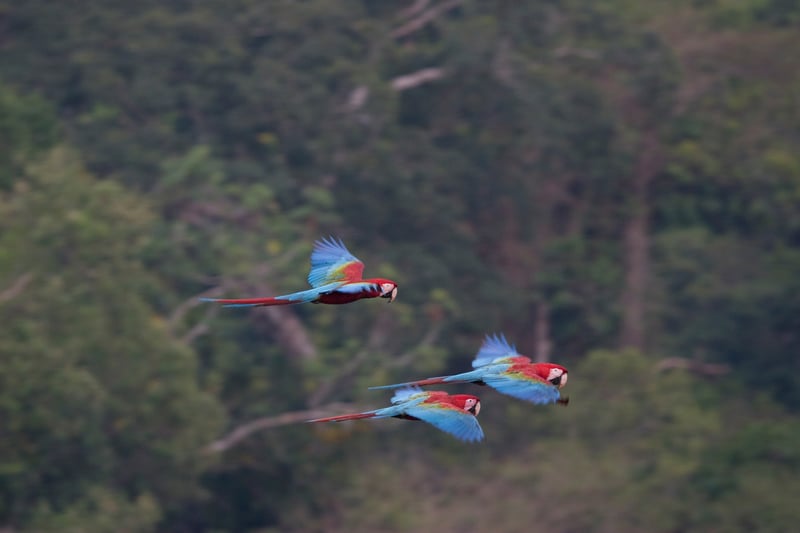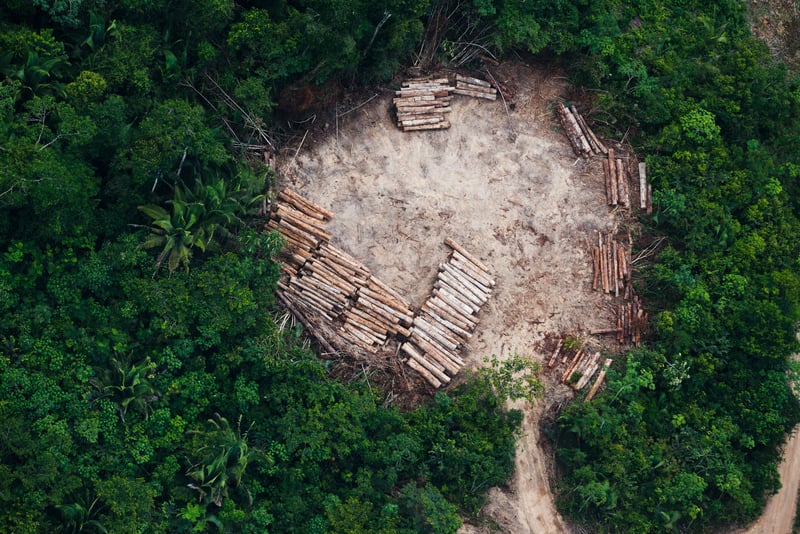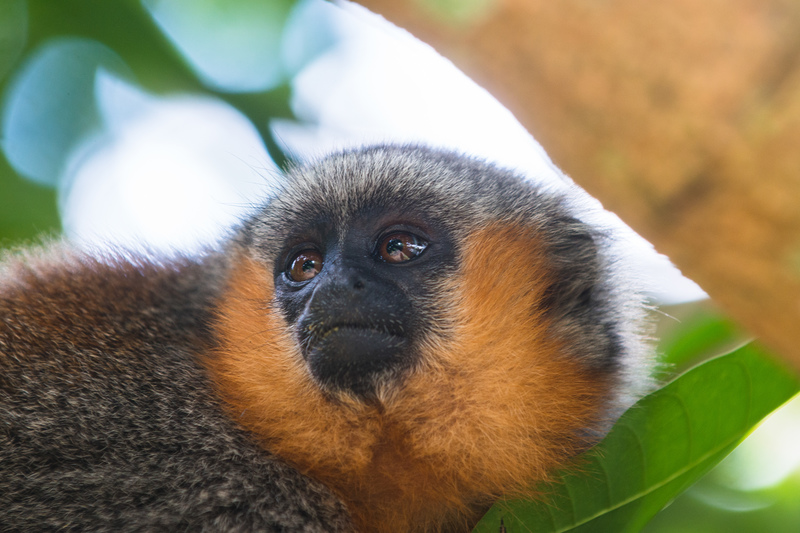What Percentage Of The World's Plant And Animal Species Are Found In The Amazon Rainforest? Quizlet
As an ecosystem, the Amazon is one of the most biodiverse places on earth. Over 3 1000000 species live in the rainforest, and over 2,500 tree species (or one-third of all tropical trees that exist on globe) help to create and sustain this vibrant ecosystem.
What is Biodiversity?
Biodiversity describes the differences and variations that exist between all living beings: animals, plants, microscopic leaner, funghi, and everything else you can imagine that is considered living. Just like there's major differences between the different types of life, like a goldfish and a firm cat, or a person and mushroom — there's also variation beyond like beings, similar an elm and a peach tree, or a beetle and a butterfly.
The remainder between all the component parts of a biodiverse system helps to keep the ecosystem and its inhabitants (including humans!) healthy. These processes help purify water, make air breathable, control outbreaks of diseases and pests, support pollination, build fertile soils, and store carbon. Biodiversity is, in a sense, what makes a place breathe, live, and stay salubrious and beautiful.

Royal flowers of the Jambo tree in Belterra.
The Amazon Rainforest and Biodiversity
Biodiversity also describes ecosystems or environments that contain a loftier caste of this variation — for example, the Amazon rainforest. Equally an ecosystem, the Amazon is i of the well-nigh biodiverse places on earth. Over 3 1000000 species live in the rainforest, and over 2,500 tree species (or one-third of all tropical trees that be on globe) help to create and sustain this vibrant ecosystem.
More than and more, biodiversity is at hazard. Both in the Amazon and globally, ecosystems are existence encroached upon, altered, and transformed past man activeness. This in turn impacts the biodiversity of an expanse and the types and quality of functions an environment tin provide.

Scarlet Macaw (Ara macao) are seen here in Cristalino Country Park. This park reserve is one of the most bio-diverse in the region and is currently nether threat from illegal logging and fire.
Drivers of Biodiversity Loss
The extinction of species is happening at rates never seen before — up to a thousand times faster than what would happen naturally. According to a recent report by IPBES (The "Intergovernmental Science-Policy Platform on Biodiversity and Ecosystem Services), an estimated 1 million species are currently facing extinction. This rate has largely picked up in the last xl years, with threatened and vulnerable species across taxa.
In the Amazon, species are threatened as human activity expands deeper into the rainforest. From August 2018 to July 2019, the Amazon lost over three,800 sq. miles of woods — an expanse equivalent to over 1.8 million football fields — which signified the highest rate of deforestation in the decade. Biodiversity loss from habitat destruction is often driven by country grabbing and industrialized agricultural expansion, mining, logging, and big-scale infrastructure development, unremarkably through deforestation. Even worse, deforestation in Indigenous lands and protected areas has skyrocketed in contempo years.
Industrial agriculture expansion, including for large industrialized crops such every bit soy and cattle, oft requires the clearing of forested areas and a more than permanent land apply modify into agricultural use. Industrialized agricultural systems, such as those based on plantations, have very niggling biodiversity, and the application of pesticides can also affect nearby ecosystems and human being communities as runoff infects the broader habitat.

Logging platform located 3km outside the Indigenous Land of Cachoeira Seca. A Greenpeace squad is in the area to witness the "Cachoeira Seca" (Dry Waterfall) Indigenous country, where illegal logging and land grabbing has been occurring.
Mining operations go deeper into the forest and drive the demand to build infrastructure (like roads) and deforest crucial habitats. Mining projects — on both the small-scale-scale and big-scale — represent a peachy risk to water and soil given the chance of toxic leaks. Mining also spreads into protected areas, such every bit Indigenous Lands and Conservation Units, and vast wild animals refuge locations.
Logging tin can besides impairment biodiversity. Greenpeace has long investigated how logging supply chains — including for high-value wood similar Ipê — can be rife with fraud, abuse, and illegally laundered timber that originates from protected areas and Indigenous reserves. In add-on, a large-scale industrial timber plantation that replaces a natural wood area will accept much less biodiversity, and is the equivalent of an agricultural "monocrop."

Aeriform photograph showing rainforest in Pará country, Brazil. The Ipê tree flowers with brilliant pink, yellow or white flowers every September. It is a valuable timber for its wood, known for its immovability, forcefulness and its natural resistance to decay. Ipê growing in the Amazon has a low population density, with an average of i tree per x hectares. This ways that large areas of forest demand to be opened up to admission these valuable trees.
Infrastructure includes roads, ability, transport networks, and other big-scale projects. BR 163 is a highway in the country of Pará (PA) that cuts into endangered species´ habitats and has fabricated the surrounding surface area subject to deforestation and habitat devastation. Other infrastructure, like hydropower dams, can deeply disrupt habitats and impact the environment, people, and biodiversity in their surroundings by isolating species and contaminating the water.
Risks and Tipping Points
The loss of biodiversity can throw an unabridged ecosystem — and the resources it provides — out of balance. It can even threaten its ability to sustain itself. One apropos case of this is the growing likelihood of massive-scale deforestation causing the Amazon rainforest to reach a "tipping point." This means that the hydrological cycle would exist disrupted to the signal that information technology triggers a massive forest "die-back" that could turn vast areas of the rainforest into a savannah, and with it lose immeasurable amounts of biodiversity.
Furthermore, there are boosted risks to destroying habitats, such every bit the increasing prevalence of zoonotic disease. Deforestation may increase the risk for disease outbreaks and can introduce new ways for zoonotic diseases to reach human communities and amplify their ability to leap across species. The Amazon rainforest has been identified equally a region with a high likelihood for future zoonotic disease emergence.
Spotlight: Hyacinth Macaw (Anodorhynchus hyacinthinus)
The Hyacinth Macaw exists naturally in the Amazon, Cerrado, and Caatinga biomes; yet agricultural expansion, illegal logging, and the advancement of cities have drastically reduced their habitat. Today it exists just in small areas of these biomes, and the species is classified as Vulnerable past the IUCN (International Union for Conservation of Nature). In the Amazon, in that location are nonetheless sightings in central Pará, the epicenter of deforestation in the biome. In 2019, the area of deforestation reached 203,460 hectares in this region.

Blueish macaw (Anodorhynchus hyacinthinus), too known as hyacinth macaw, in Miranda, Mato Grosso do Sul state, Brazil.
This is one of many species in the Cerrado threatened by the agribusiness expansion fueled by a high production of soy and corn for consign. This predatory model puts traditional communities and natural resources at risk.
What's beingness done to protect biodiversity globally and in the Brazilian Amazon?
Some of the about important things we can do to protect biodiversity are:
- Protect Ethnic people and their rights and enforce existing protections. Nearly one million Indigenous people in Brazil phone call the Amazon rainforest their home. Indigenous communities have a correct to their livelihoods in their territories, and it is our global responsibleness to push button dorsum when their protections and livelihoods are put at risk and violated. There'southward been a steady rollback of ecology protections and enforcement under the Bolsonaro government that is harming Indigenous communities, which has only connected nether COVID-19 and leading deforestation and habitat destruction.

Indigenous leaders from Brazil and Greenpeace Germany activists peacefully demonstrate at the Consumer Goods Forum (CGF) Sustainability Committee Meeting in Berlin against some of the globe'south biggest brands, including Nestle, Unilever and Mondelēz, to demand they end their role in forest destruction in the Amazon and beyond Brazil.
- Promote greater science, research, and understanding on biodiversity, especially for Brazilians. In the concluding iv years there's been over 600 new species of plants and animals discovered in the Amazon. Too often, these species are discovered subsequently their habitats take been encroached upon, when they are already at run a risk. Nosotros need to invest more than in scientific inquiry programs — similar the Tatiana de Carvalho Programme, a Greenpeace Brazil scholarship program for students researching the Amazon. Without proper written report, we tin can't know how or what we're losing or risking when we introduce radical shifts into the environment.
- Rethink how we collaborate with biodiversity and nature and address the harm already caused by our current systems. In the US, this will hateful re-thinking if what we consume or produce is based on sourcing practices that are often detrimental to delicate ecosystems. Destroyed forests and fragmented habitats can exist restored, and there are alternatives to the industrialized nutrient systems that are harming biodiversity, local communities, workers, and consumers. By protecting biodiversity, we tin besides have positive effects on forests, the climate, and communities effectually the earth.
Spotlight: Milton's Titi (Plecturocebus miltoni)
Outset catalogued in 2014, this primate species only exists at the intersection of the Roosevelt and Aripuanã rivers in united states of Mato Grosso and Amazonas, Brazil. From January to September 2019, 204 burn hotspots were recorded within a radius of up to 30 kilometers from where the species lives. Over the by yr, the region has lost 3,130 hectares of forest. Because it lives exclusively in the treetops, the loss of forest encompass is fatal for this species. Its main threats are fires and forest deposition.

Titi monkey (genus Callicebus). Sawré Muybu Ethnic Land, home to the Munduruku people, Pará state, Brazil.
Conclusion
2020 was set up to be a big year for nature and biodiversity. The Convention on Biological Diversity (CBD) was set to reset their 10-year priorities for protecting nature and biodiversity. Unfortunately, many of the Aichi Targets cruel short — including Target eleven to bring more terrestrial, inland h2o, and marine areas into protected or conservation status. This ways we need even bigger and bolder activity to protect nature.
While there accept been some promising steps for corporate actions and government policy signals for forests and the climate — such equally goose egg-deforestation commitments, moratoriums, streamlining climate into trading agreements, and increasing the expanse under protection and conservation — many commitments have not yet translated to effective activity, and the successes are under threat or only partially implemented.
Our current path is not sustainable. We need to follow through on our commitments, and reconsider our relationship to biodiversity and nature. It'southward becoming more than and more articulate that if nosotros neglect to protect nature, we'll but further compromise nature'southward ability to provide for us and our collective well-being.
Source: https://www.greenpeace.org/usa/biodiversity-and-the-amazon-rainforest/
Posted by: ballthismillond.blogspot.com

0 Response to "What Percentage Of The World's Plant And Animal Species Are Found In The Amazon Rainforest? Quizlet"
Post a Comment